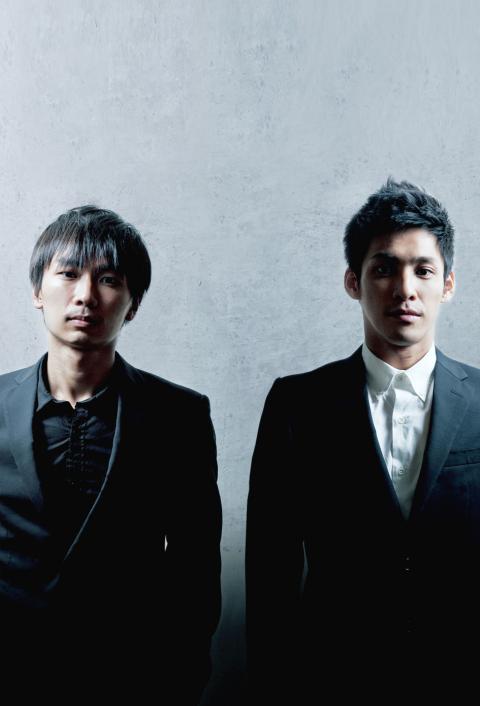The second program in the National Theater Concert Hall’s 2012 Dancing into Autumn series has been long awaited since it marks the return of Taiwan’s dance world enfant terrible to the stage after an absence of almost two years.
Huang Yi (黃翊) wowed audiences in March 2008 with Body, Sound (身音), which he choreographed for Cloud Gate 2 while he was still a student at Taipei National University of the Arts, with its mix of eye-popping costumes and dancers creating their own score as they moved. He kept wowing them with pieces for that troupe, like TA-TA for Now and Violin — Symphony Project I (機械提琴—交響樂計畫之一), which featured computer-played violins.
There was also the work Huang did in his own name, such as Spin series. The 50-minute Spin 2010, Huang’s last work before he took a hiatus to do his military service, built on pieces he had been doing since 2006, works that combined his love of dance and his love of technology (a video camera, for example, or a crane arm).

Photo Courtesy of NTCH
Now he’s back, but with a show that has been stripped down to the basics, just two performers (including himself), and a musician.
Opening tonight at Taipei’s Experimental Theater, Double Yellow Lines (雙黃線) sees Huang teaming up with dancer Hu Chien (胡鑑) and French-Vietnamese composer An Ton That (孫仕安), also known as Anken. The 60-minute piece could be labeled “Huang Yi, unplugged” and it promises to be something special.
Huang has known Hu and An for several years.
He met Hu at graduate school at TNUA and they have worked together on various projects for about five years.
“I found his movement quality unique; he has very natural movement feeling that is really different from my physical feeling; so I decided to keep working with him,” Huang said in an e-mail interview.
He said he began working on the show in April and said he took inspiration from his daily life.
“To me, Double Yellow Lines is not just dance. It’s a record of my life. I tried to put some personal stories or feelings into this series, it’s really different from other types. For me it’s like a treasure. Most of the time I don’t have the opportunity to do that,” Huang said.
Double Yellow Lines marks a departure for Huang, and not just because he has put all his high-tech toys to one side.
“It’s my first time to collaborate with someone. I still choreographed most of the sections, but I started to listen to my collaborators [Hu and An], [and] changed most of my original ideas because the collaborators. I think it’s a good start, they pushed me to discover more possibilities of performing and music,” he said.
Huang has worked with An before — they did Symphony Project and Second Skin — but the music was always pre-recorded for those shows.
“This time I am trying to go back to the traditional way of ‘live music and dance,’ like an unplugged concert. Now I know it’s not an easy way, I learned so much this time, and it has given me many ideas for my future works,” he said.

Desperate dads meet in car parks to exchange packets; exhausted parents slip it into their kids’ drinks; families wait months for prescriptions buy it “off label.” But is it worth the risk? “The first time I gave him a gummy, I thought, ‘Oh my God, have I killed him?’ He just passed out in front of the TV. That never happens.” Jen remembers giving her son, David, six, melatonin to help him sleep. She got them from a friend, a pediatrician who gave them to her own child. “It was sort of hilarious. She had half a tub of gummies,

June 23 to June 29 After capturing the walled city of Hsinchu on June 22, 1895, the Japanese hoped to quickly push south and seize control of Taiwan’s entire west coast — but their advance was stalled for more than a month. Not only did local Hakka fighters continue to cause them headaches, resistance forces even attempted to retake the city three times. “We had planned to occupy Anping (Tainan) and Takao (Kaohsiung) as soon as possible, but ever since we took Hsinchu, nearby bandits proclaiming to be ‘righteous people’ (義民) have been destroying train tracks and electrical cables, and gathering in villages

Swooping low over the banks of a Nile River tributary, an aid flight run by retired American military officers released a stream of food-stuffed sacks over a town emptied by fighting in South Sudan, a country wracked by conflict. Last week’s air drop was the latest in a controversial development — private contracting firms led by former US intelligence officers and military veterans delivering aid to some of the world’s deadliest conflict zones, in operations organized with governments that are combatants in the conflicts. The moves are roiling the global aid community, which warns of a more militarized, politicized and profit-seeking trend

The wide-screen spectacle of Formula One gets a gleaming, rip-roaring workout in Joseph Kosinski’s F1, a fine-tuned machine of a movie that, in its most riveting racing scenes, approaches a kind of high-speed splendor. Kosinski, who last endeavored to put moviegoers in the seat of a fighter jet in Top Gun: Maverick, has moved to the open cockpits of Formula One with much the same affection, if not outright need, for speed. A lot of the same team is back. Jerry Bruckheimer produces. Ehren Kruger, a co-writer on Maverick, takes sole credit here. Hans Zimmer, a co-composer previously, supplies the thumping